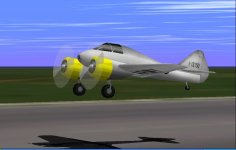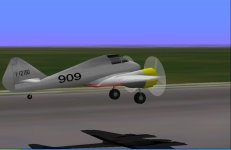Hello Aleatorylamp,
I only pulled out the AIR file from the last version you sent. I didn't even check for the improved visual model or for a DP file.
I believe in looking at some drawings that the reason the AT-9 was so unstable was because it typically had a CoG that was pretty far aft. That was indicated by the position of the aircraft lifting lugs on the wing roots. They were a bit far back from where I would have expected to find the wing's center of lift.
I finally got my version of the AT-9 off the ground.
I am following my own "Process" for creating a new AIR file in starting with a stock P-51D
I found one glaring error in my instructions thus far: I forgot to list editing the Fuel Tanks.
The engine power is still down around 236 HP at 500 feet and I have done no performance testing at all.
Interestingly, I have no trouble getting near 2300 RPM (actually around 2298 until pilot sets prop for maximum RPM).
The handling is a bit twitchy at the moment since I have not changed any non-essential parameters from the P-51D.
Another interesting thing is that the cockpit POV from the P-51D was good enough to fit your model.
I am following my own recommendations for Engine Tuning first and THEN Propeller Tuning.
By the way, can you figure out WHY the performance dropped when you increased the Propeller Diameter?
It will be a while yet.
- Ivan.
I only pulled out the AIR file from the last version you sent. I didn't even check for the improved visual model or for a DP file.
I believe in looking at some drawings that the reason the AT-9 was so unstable was because it typically had a CoG that was pretty far aft. That was indicated by the position of the aircraft lifting lugs on the wing roots. They were a bit far back from where I would have expected to find the wing's center of lift.
I finally got my version of the AT-9 off the ground.
I am following my own "Process" for creating a new AIR file in starting with a stock P-51D
I found one glaring error in my instructions thus far: I forgot to list editing the Fuel Tanks.
The engine power is still down around 236 HP at 500 feet and I have done no performance testing at all.
Interestingly, I have no trouble getting near 2300 RPM (actually around 2298 until pilot sets prop for maximum RPM).
The handling is a bit twitchy at the moment since I have not changed any non-essential parameters from the P-51D.
Another interesting thing is that the cockpit POV from the P-51D was good enough to fit your model.
I am following my own recommendations for Engine Tuning first and THEN Propeller Tuning.
By the way, can you figure out WHY the performance dropped when you increased the Propeller Diameter?
It will be a while yet.
- Ivan.




